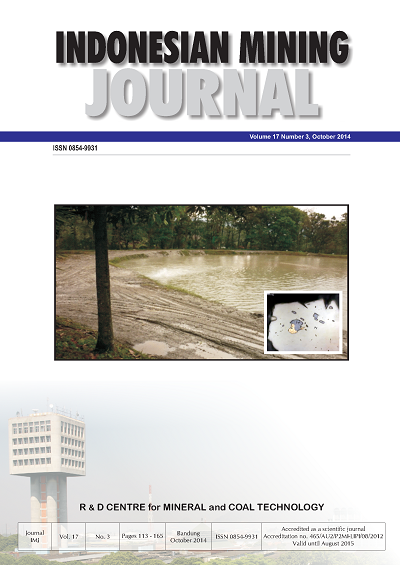BENEFICIATION OF SAMBIROTO SILICA SAND BY CHEMICAL AND BIOLOGICAL LEACHINGS
DOI:
https://doi.org/10.30556/imj.Vol17.No3.2014.318Keywords:
beneficiation, silica sand, chemical leaching, bioleaching, metallurgical grade siliconAbstract
The commercial value of silica sand significantly affected by the presence and content of iron, aluminium and other metal impurities that can have detrimental effects on the manufactured product. A leaching technology on Sambiroto silica sand had been studied using chemical (HCl and H2SO4) and biological (Aspergillus niger’s metabolite) methods to remove undesired metal impurities and obtain a high purity silica. The rates and extent of chemical leaching and bioleaching were different depending on the leaching agents used and their concen- trations. The results showed that the laboratory experiments improved the silica sand sample to a high grade purity. The major and minor impurities of Fe, Al, Ca, Cr, Ti, Zr and Cu were reduced significantly by acid leaching with HCl and H2SO4 4M at 90°C, 30% pulp density for 4-hours process. The chemical composition of the silica sand improved with the SiO2 content increased from 97.24 to 98.77%, on the other hand, the sum of impurities decreased from 1.148 to 0.237 %. These changes bring the beneficiated product very close to a feedstock of metallurgical grade silicon for advanced materials. Among the tested methods, chemical leaching is the most efficient in terms of both increasing percentage of SiO2 and metal impurities removal compared to biological leaching. Nevertheless, bioleaching process is sufficient to produce silica sand with a desired minimum value of Fe and Al contents for high quality glass industries. Both process characteristics could facilitate their industrial applications.
References
Akril, A. 2007. Potential bioleaching developments towards commercial reality: Turkish metal mining’s future. Miner Eng 17, p477-480
Anjum, F., Bhatti, H.N., Asgher, M., and Shahid, M., 2010. Leaching of metal ions from black shale by organic acids produced by Aspergillus niger. Ap- plied Clay Science 47(3-4), p356-361.
Alafara, A.B., Adekola, F.A., Folashade, A.O., 2005. Quantitative leaching of a Nigerian iron ore in hy- drochloric acid. J.Appl.Sci.Environ.Manage Vol.9 No. 3, p 15.
Aung, K.M.M. and Ting, Y.P., 2005. Bioleaching of spent fluid catalytic cracking catalyst using Aspergillus niger. J.Biotechnol 116, p159-170.
Banza, A.N., Quindt Jgock, E., 2006. Improvement of the quartz sand processing at Hohenbocka, Min. Proc., p76-82.
Cameselle C., Ricart M.T., Nunez M.J., and Le,a, J.M., 2003. Iron removal from kaolin comparison between in-situ and two-stages bioleaching pro- cesses. Hydrometallurgy 68 (1-3), p 97-105.
Dal Martello, E., Bernardis, S., Larsen, R.B., Tranell G., Di Sabatino, M., Arnberg, L., 2012. Electrical fragmentation as a novel route for the refinement of quartz raw material for trace mineral impurities. Powder Technology 224, p209-216.
Daykh, A.B., and Mahdy, N.S., 2005. Beneficiation of silica sand for scientific glass industry. Geosurvey report no.2888.
Handayani, S., 2011. Effects of temperature and nutri- ent feed on the production of oxalic acid by Asper- gillus niger. Indonesian Mining Journal Vol.14, No.3, p108-114.
Haus, R., 2010. High-purity quartz resources. Photon’s 8th solar silicon conference, Stuttgart.
Haus, R., 2005. High demands on high purity. Ind Miner 10, p62-67.
Hosseini, M.R., Pazouki, M., Ranjbar, M. and Habibian M., 2007. Bioleaching of iron from highly contami- nated kaolin clay by Aspergillus niger. Appl. Clay Sci 37, p251-257.
Jaisi, D.P., Dong, H., Lin, L., 2007. Influence of biogenic Fe(II) on the extent of microbial reduction of Fe(III) in clay minerals nontronite, illite, and chlorite. Geo- chim.Cosmochim. Acta 71, p1145–1158.
Ledgerwood, J. and van der Westhuyzen, P., 2011. The use of sulphuric acid in the mineral sands in- dustry as a chemical mechanism for iron removal. 6th Soutern African base Metals Conference, p169-185.
Lee, S.O., Tran, T., Jung, B.H., Kim, S.J., Kim, M.J. 2007. Dissolution of iron oxide using oxalic acid. Hydrometallurgy 87 No.3-4, p91-99.
Mulligan, C.N., Kamli, M., and Gibbs, B.F., 2004. Bioleaching of heavy metals from low grade ore using Aspergillus niger. J. Hazardous Material 110(1-3) p77-84.
Mustafa, A.M.K., Bader, N.D., Khachiek, T.V., Fleah, I.K., and Issa, I.G., 2011. Biobeneficiation of silica sand for crystal glass industry from Ardhuma loca- tion, Iraqi Western Dessest. Iraqi Bulletin of Geol- ogy and Mining Vol.7, No.1, p77-86.
Rawlings, D.E., 2004. Microbially assisted dissolution of minerals and its use in the mining industry. Pu- reAppl.Chem 76(4), p847-859.
Salmimies, R., Manilla, M., Kallas, J., and Hakkinen, A., 2012. Acidic dissolution of hematite: kinetic and thermodynamic investigation with oxalic acid. Int. J. of Mineral Processing 110-111, p121-125.
Wan-Xia R., Pei-Jun L., Yong G., Xiao-Jun L., 2009. Biological leaching of heavy metals from a con- taminated soil by Aspergillus niger. J.Hazardous Material 167, p164-169.
Xakalashe, B.S., and Tangstad, M., 2011. Silicon pro- cessing: From quartz to crystalline silicon solar cells. Southern African Pyrometallurgy 2011, Edited by R.T. Jones & P. den Hoed, Southern African Institute of Mining and Metallurgy, Johannesburg, 6-9 March 2011
Downloads
Issue
Section
License
Indonesian Mining Journal provides immediate open access to its content on the principle that making research freely available to the public to supports a greater global exchange of knowledge.

This work is licensed under a Creative Commons Attribution-NonCommercial 4.0 International License.













